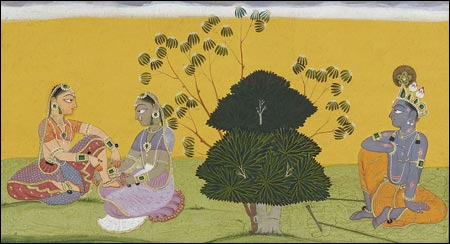“Cosmophilia,” the breathtaking exhibit at Boston College’s McMullen Museum, examines Islamic art through its “love of ornament.” Indian miniatures astonish with their mix of fantastic stories and imagery, but these works are powered by pure sensation. BC professors (and wife and husband) Sheila Blair and Jonathan Bloom assembled more than 100 works from the David Collection in Copenhagen to study decoration — figures, calligraphy, geometry, floral pattern — emerging from the Islamic cultures of Western Europe to East Asia from the seventh to the 19th century.

ASKING HER TO LEAVE HER NOISY ANKLETS BEHIND AND GO: The romantic charge of Indian miniatures comes from their focus on relationships.
|
The professors explain that Islamic prohibitions against idolatry banned pictures of people and animals from religious sites, but figurative imagery remained present in everyday places. Such imagery still bothered some folks, though, like the person who registered his offence by drawing red slashes across the necks of all the figures of a 16th-century Iranian manuscript painting of a court feast.
The upshot is that abstracted pattern dominated art from these cultures. Calligraphy thrived because it honored the word of God as revealed to the Prophet Muhammad in the Koran. Artists also favored floral and geometric designs that seem to pulse and radiate. Sometimes the effect is literal, as when you look through the open metalwork of a 15th-century Iranian candlestick and see the pattern on the other side. The matching designs vibrate against each other as you move your head.
A circular cloth is ingeniously and painstakingly fashioned from small pieces of silk satin so that the fabric bends slightly this way and that to create a subtle pattern of light and shadow underneath the fabric’s colors. Stars and hexagons radiate across a tall, narrow, 17th-century Iranian door. Patterns are often carved deep into wood or marble, creating contrasts of light and dark that make the designs seem to float above the surface.
The artist of a 19th-century sheet of calligraphy arranged the devotional script in the shape of a sad-eyed lion. At first the design appears simply to be white pigment on a black background, but closer inspection reveals it to be a sheet of white paper that has been miraculously cut out into an intricate web of patterns.
Floral patterns, adopted from Mediterranean and Persian cultures, were attractive in parched Islamic lands and may also refer to the Garden of Paradise promised in the Koran. Blue and white flowering plants decorate a set of 16th-century glazed tiles from Turkey. The plants form a repeating motif of white flowers woven with green leaves. The pattern is plainly apparent, but through some magic the stems seem to sway as if blown by a cool breeze.
“Domains of Wonder: Masterworks of Indian Painting” | Museum of Fine Arts, 465 Huntington Ave, Boston | through November 26
“Cosmophilia: Islamic Art from the David Collection, Copenhagen” | McMullen Museum of Art, Boston College, 140 Comm Ave, Chestnut Hill | through December 31